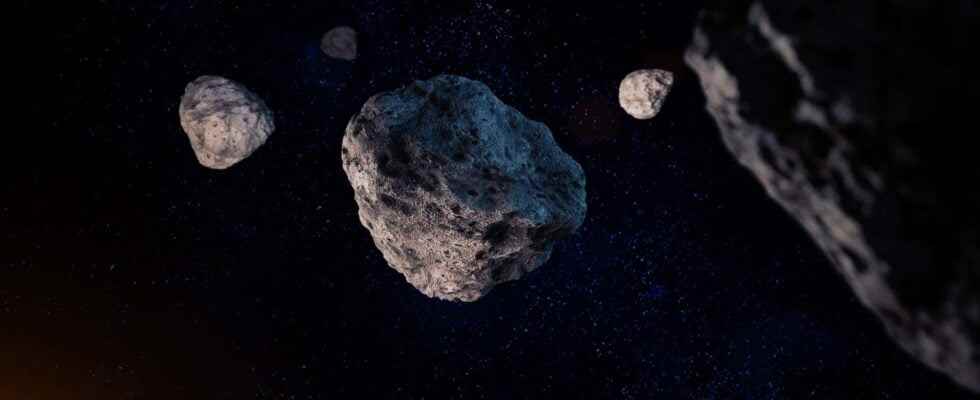You will also be interested
[EN VIDÉO] 2028, an asteroid threatens the Earth Among the roles of the European Space Agency (ESA): to protect us from threats from space. Debris from satellites or rockets, solar activity, but also asteroids. In this scenario, ESA experts suggest that we project ourselves into 2028, when a huge asteroid is on its way to Earth. And find out how the planetary defense office is trying to gather as much information as possible about the potential impact. (in English) © ESA
A third moon was discovered around (130) Elektra, a towering main-belt asteroid, making it the first quadruple system ever identified. That new Moon has been detected in data acquired using the spectro-imager (IFS) of Sphere (Spectro-Polarimetric High-contrast Exoplanet REsearch instrument), mounted on one of the four telescopes from VLT in Chile.
If the performance of this instrument and its adaptive optics extreme are no longer to be demonstrated, this discovery was made possible thanks to the development of two new algorithms. The first is a data reduction algorithm that makes it possible to go from raw instrumental data, which is difficult to interpret, to so-called reduced data, which can be analyzed by astronomers. The second is an image processing algorithm to estimate and remove the very bright halo of (130) Elektra in which the potential moons are hidden.
Asteroid Elektra is the most intriguing, known to have not one but two orbiting moons (in orange and green) and now a third (blue orbit) has just been located closer to its asteroid. © ESO/Berdeu and para.Yang and para.
Better understand the formation mechanisms of these satellites
The study of multiple asteroids helps to better understand the origin of asteroids. The images of these systems make it possible to determine the orbital parameters of the satellites from which we deduce parameters physical as the mass of the asteroid. The images also make it possible to deduce the shape and size of these objects (for the largest of them). By combining their mass and their volume, we obtain their density, which is perhaps the most fundamental information for understanding their composition, which itself goes back to the origins of Solar system.
However, many questions remain unanswered: how exactly do these satellites form? Why do some types (compositions) of asteroids not have satellites? Is the formation linked to the composition? Or is it the stability of these satellites that is in question? Each new moon discovered makes it possible to replace the asteroid around which it orbit in a more general context and to refine our understanding of these small bodies.
Electra is the first quadruple asteroid discovered
(130) Electra was already known to be surrounded by two satellites. New observations of the system have revealed a third companion, making it the asteroid with the most satellites identified to date.
Article by Arien Coffinet, published on November 14, 2021
(130) Electra is an asteroid orbiting in the outer part of the main belt, between 370 and 566 million kilometers from the Sun. It was discovered on February 17, 1873 by Christian Peters from the Litchfield Observatory inHamilton Collegein Clinton, New York (USA).
This small, rather irregularly shaped body, named after the homonymous character from Greek mythology, measures 262 × 205 × 164 kilometers, making it one of the largest main belt asteroids. He has a spectrum of type G and therefore probably a composition similar to that of Ceres. Spectral signatures of organic compounds have been observed on the surface of Electra and it shows signs of aqueous weathering.
An asteroid already known to be accompanied
More than 400 minor planets (asteroids, transneptunians and other small non-cometary bodies) are known to date to have at least one satellite.
A first satellite was discovered around Electra on August 15, 2003 by a team of astronomers led by William J. Merline using the telescope Keck II from Mauna Kea Observatory in Hawaii. This little companion, provisionally designated S/2003 (130) 1, is Electra’s largest and most external. It measures about six kilometers and circles its host in 5.3 days at an average distance of 1,298 kilometers.
One second satelliteS/2014 (130) 1, was discovered around Electra on December 6, 2014 by Bin Yang and his collaborators using the adaptive optics system Sphere on the Melipal telescope (UT3) of the Very Large Telescope in Cerro Paranal, Chile. This third member of the system measures about two kilometers and is 498 kilometers from Electra, around which it orbits in 1.3 days.
Observations in the near infrared had shown that S/2003 (130) 1 and S/2014 (130) 1 present a spectrum similar to that of Electra. These observations support the hypothesis that the satellites of Electra would be fragments of the asteroid ejected by collision.
Never two without three ?
Further observations with VLT-SPHERE, carried out between December 9 and 31, 2014, have just revealed a third companion of Electra, which has not yet been assigned an official designation (this should normally be S/2014 (130 ) 2). This new satellite, the discovery of which was announced on November 6, 2021 by astronomers Anthony Berdeu, Maud Langlois and Frédéric Vachier, measures 1.6 kilometers in diameter. It orbits 345 kilometers from Electra and circles it in 0.7 days.
This discovery makes Electra the first quadruple asteroid system discovered and imaged in the Main Belt. The only bodies known to have more companions are the dwarf planet Plutowho has fiveand the four giant planetsthat is to say Jupiter, Saturn, Uranus and Neptunewhich we know respectively 79, 82, 27 and 14 satellites.
Are there still other companions to discover around Electra? Only observations even more advancedand why not one day a space probecan tell us.
Interested in what you just read?
